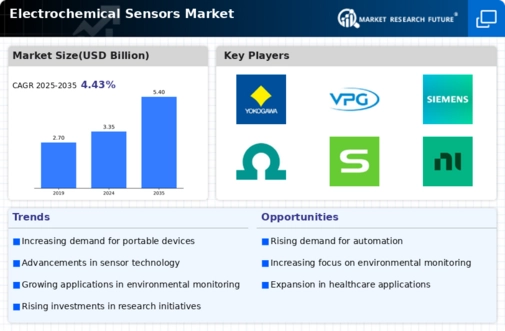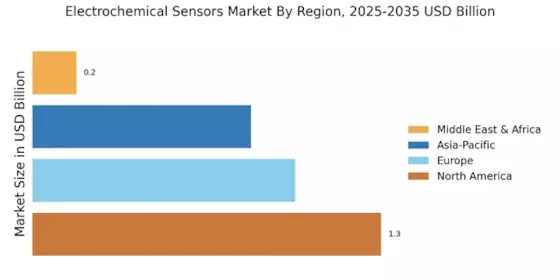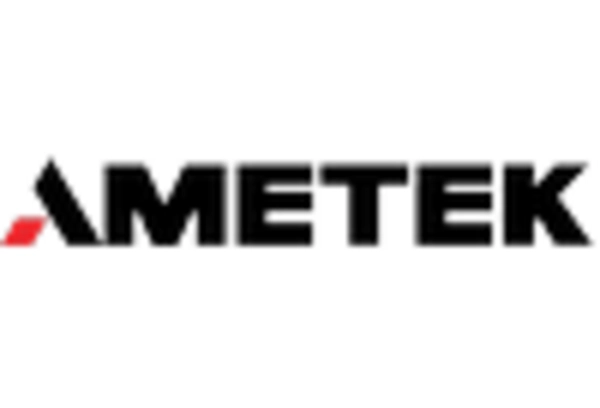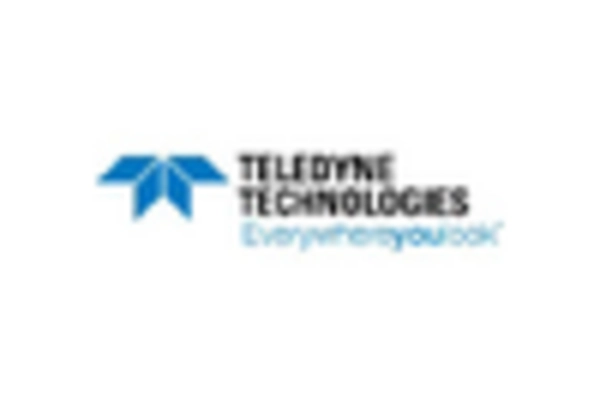Rising Demand for Wearable Devices
The Electrochemical Sensors Market is experiencing a notable surge in demand for wearable devices, which are increasingly integrated with electrochemical sensors for health monitoring. These sensors facilitate real-time tracking of vital parameters such as glucose levels, heart rate, and hydration status. The market for wearable health technology is projected to reach approximately 60 billion USD by 2026, indicating a robust growth trajectory. This trend is driven by a growing consumer focus on health and wellness, alongside advancements in sensor technology that enhance accuracy and reliability. As a result, manufacturers are investing in the development of innovative electrochemical sensors tailored for wearable applications, thereby expanding their market presence and catering to the evolving needs of consumers.
Increasing Applications in Food Safety
The Electrochemical Sensors Market is witnessing an expansion in applications related to food safety, driven by heightened consumer awareness regarding food quality and safety standards. Electrochemical sensors are employed to detect contaminants, pathogens, and chemical residues in food products, ensuring compliance with regulatory requirements. The food safety testing market is anticipated to grow significantly, with estimates suggesting it could reach 20 billion USD by 2025. This growth is largely attributed to the increasing incidence of foodborne illnesses and the demand for rapid testing methods. Consequently, the integration of electrochemical sensors in food safety protocols is becoming essential, thereby propelling the market forward and fostering innovation in sensor technology.
Advancements in Environmental Monitoring
The Electrochemical Sensors Market is significantly influenced by advancements in environmental monitoring technologies. These sensors are pivotal in detecting pollutants and hazardous substances in air, water, and soil, thereby supporting environmental protection efforts. The market for environmental monitoring is projected to grow, with estimates indicating a potential value of 15 billion USD by 2025. This growth is driven by regulatory pressures and public awareness regarding environmental issues. Electrochemical sensors offer advantages such as high sensitivity and selectivity, making them ideal for real-time monitoring applications. As environmental regulations become more stringent, the demand for reliable electrochemical sensors is likely to increase, further driving market expansion.
Growing Demand in Automotive Applications
The Electrochemical Sensors Market is experiencing a growing demand for sensors in automotive applications, particularly for emissions monitoring and vehicle diagnostics. Electrochemical sensors are utilized to measure gas concentrations, such as carbon monoxide and nitrogen oxides, which are critical for ensuring compliance with environmental regulations. The automotive sensor market is projected to reach approximately 30 billion USD by 2026, driven by the increasing focus on reducing vehicle emissions and enhancing fuel efficiency. As automotive manufacturers strive to meet stringent emission standards, the integration of advanced electrochemical sensors is becoming essential. This trend not only supports regulatory compliance but also promotes the development of cleaner and more efficient vehicles, thereby driving the overall market.
Technological Innovations in Sensor Design
The Electrochemical Sensors Market is propelled by ongoing technological innovations in sensor design and materials. Recent advancements have led to the development of more sensitive, selective, and miniaturized sensors, which are crucial for various applications, including medical diagnostics and industrial monitoring. The market for advanced sensor technologies is expected to grow, with projections suggesting a compound annual growth rate of around 8% over the next five years. Innovations such as nanomaterials and smart sensor technologies are enhancing the performance of electrochemical sensors, making them more efficient and cost-effective. This trend is likely to attract investments and foster collaborations among industry players, thereby stimulating market growth.

















Leave a Comment